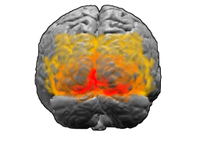
Photo from wikipedia
Accurate heading perception relies on visual information integrated across a wide field, that is, optic flow. Numerous computational studies have speculated how local visual information might be pooled by the… Click to show full abstract
Accurate heading perception relies on visual information integrated across a wide field, that is, optic flow. Numerous computational studies have speculated how local visual information might be pooled by the brain to compute heading, but these hypotheses lack direct neurophysiological support. In the current study, we instructed human and monkey subjects to judge heading directions based on global optic flow. We showed that a local perturbation cue applied within only a small part of the visual field could bias the subjects' heading judgments, and shift the neuronal tuning in the macaque middle temporal (MT) area at the same time. Electrical microstimulation in MT significantly biased the animals' heading judgments predictable from the tuning of the stimulated neurons. Masking the visual stimuli within these neurons' receptive fields could not remove the stimulation effect, indicating a sufficient role of the MT signals pooled by downstream neurons for global heading estimation. Interestingly, this pooling is not homogeneous because stimulating neurons with excitatory surrounds produced relatively larger effects than stimulating neurons with inhibitory surrounds. Thus our data not only provide direct causal evidence, but also new insights into the neural mechanisms of pooling local motion information for global heading estimation.
Journal Title: Cerebral Cortex
Year Published: 2018
Link to full text (if available)
Share on Social Media: Sign Up to like & get
recommendations!